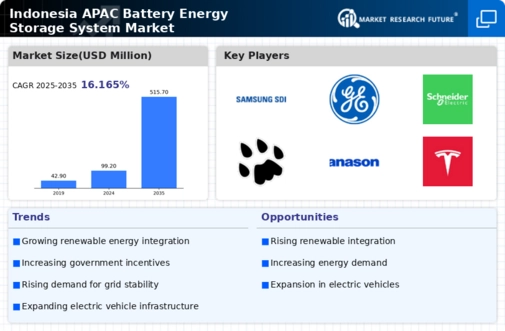The competitive landscape of the Indonesia APAC Battery Energy Storage System Market is rapidly evolving, driven by advancements in battery technology, increased demand for renewable energy sources, and supportive government initiatives. With Indonesia aiming for a significant transition toward sustainable energy solutions to combat climate change and promote energy independence, various players are stepping up to establish their foothold in the market. The increasing integration of renewable energy into the grid has created a robust opportunity for energy storage systems that ensure stability, reliability, and efficiency in energy supply.
As investments grow and technological innovations emerge, stakeholders are vying for market share, highlighting the importance of strategic partnerships, mergers, and the development of cutting-edge products to stay ahead in this competitive arena.Samsung SDI stands out in the Indonesia APAC Battery Energy Storage System Market for its innovative solutions and strong technological capabilities. The company has developed a reputation for producing high-performance lithium-ion batteries, which are integral to energy storage systems that support grid stabilization and renewable energy integration.
With its robust manufacturing capabilities and established supply chain, Samsung SDI has managed to create a solid market presence in Indonesia, providing ample batteries that cater to both utility-scale and commercial energy storage needs. The company's ongoing research and development efforts emphasize efficiency and advanced safety technologies, enabling it to maintain a leading edge over competitors.
Furthermore, Samsung SDI's commitment to sustainability aligns well with Indonesia's ambition for cleaner energy solutions, making it a pivotal player in addressing the nation’s energy challenges.General Electric has made significant inroads in the Indonesia APAC Battery Energy Storage System Market, distinguishing itself with a comprehensive portfolio of energy management solutions and services. The company excels in providing integrated battery storage systems that seamlessly align with renewable energy generation, especially solar and wind power. Its product offerings not only enhance grid reliability but also facilitate cost savings for utility providers and consumers alike.
GE's strength lies in its extensive experience in energy infrastructure and its commitment to innovation, allowing it to deliver advanced energy storage solutions tailored specifically to the Indonesian market's unique challenges and requirements. Additionally, GE has engaged in strategic collaborations and partnerships within the region to empower its market presence further, bolstering its ambition to support Indonesia’s energy transition. Through these initiatives and a focus on continuous improvement, General Electric enhances its capacity to meet the growing demand for efficient energy storage systems while contributing to the wider goal of sustainability in Indonesia.























Leave a Comment